AMRs improve customer service, global competitiveness
Window and door manufacturer adopts autonomous mobile robots and lean manufacturing model with Industry 4.0 technology.
Founded 40 years ago, Sunview Patio Doors in Woodbridge, Ontario, manufactures 70,000 to 80,000 units annually for customers around the world. When a new leadership team took over the business in 2008, it focused on increasing productivity with industrial automation. As part of its transformation, the company replaced forklifts and manual carts with autonomous mobile robots (AMRs).
The industry had undergone significant changes, with fewer standard windows and patio doors and significantly increased varieties of size, thickness and material. Leadership sought a solution to meet customers’ growing demands for faster and better service while providing product customization. That translated into a lot of material movement inside the factory, which presented complex logistical issues.
“Customers began to expect those options, and the facility wasn’t set up that way,” says Tony Margiotta, president at Sunview. “To be successful moving forward, we needed to move to a flexible manufacturing model.”
The company investigated solutions to ensure the right materials were delivered to the right spot at the right time, and they wanted a safer option than adding more tow-motors.
“It’s very easy to become complacent when you deal with something repetitive every day,” says Kurt Oberparleiter, vice president of operations. “Tow-motors can be extremely dangerous. They’re stronger than a car, driving around within inches of people, which obviously impacts safety.”
They initially looked at automatic guided vehicles (AGVs) relying on guidance methods like magnetic tape, beacons, bar codes or predefined laser paths that allow the vehicles to travel on fixed paths in a controlled space.
The new AMRs (OTTO Motors) they chose are self-driving and use laser-based perception and artificial intelligence to dynamically move without guidance infrastructure. Onboard sensors and software allow each unit to understand its environment and adapt to changes in real time, detecting and avoiding people, obstacles and equipment. The solution combines the benefits of manual labor, conveyors and AGVs.
Fleet management software offers a central dispatch and command center to manage the AMRs. With an integrated lift attachment, an AMR arrives at the pick-up and delivery station for an empty pallet. This is also where AMRs charge. The AMR picks up the finished goods and delivers them to the automated storage and retrieval system.
Oberparleiter says the equipment has a 100% safety rate, and Sunview was able to reach an ROI in 16 months. In total, the AMRs have traveled 930,000 miles and moved 2.7 million pounds. Phase two is underway to add more units.
“They filled a niche that was incredibly tough to do. I didn’t even think it was possible,” Oberparleiter says. “It runs like a bus. The vehicle drives around objects that are put in its way and fulfills a need that a human, quite frankly, couldn’t do. It’s just there, the minute you need it.”













